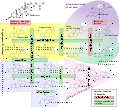
Cholesterol side-chain cleavage enzyme
Encyclopedia
Cytochrome P450, family 11, subfamily A, polypeptide 1 (P45011a1), often referred to as P450scc (or 20,22-desmolase
), is a mitochondrial enzyme
associated with the conversion of cholesterol
to pregnenolone
. The gene
name is CYP11A1. The term "desmolase" is becoming outdated and the enzyme is now commonly referred to as P450scc, where "scc" refers to side-chain cleavage
.
The protein is a member of the cytochrome P450 superfamily of enzymes. It catalyzes the first step in all steroid hormone
production -- the conversion of cholesterol
to pregnenolone
, the first steroid formed:
The protein resides on the inner mitochondrial membrane
, facing the interior (matrix). The presence of this enzyme defines if a cell is steroidogenic. Consequently, P450scc is found in all steroid-producing cell types such as theca cells and luteal cells in the ovary
, Leydig cells in the testis, and cell types in the adrenal cortex
.
s of the cholesterol side-chain, which generate, first, 22R-hydroxycholesterol and then 20alpha,22R-dihydroxycholesterol. The final step cleaves the bond between carbons 20 and 22, resulting in the production of pregnenolone and isocaproic acid.
Each step requires 2 electron
s (reducing equivalents). These are provided by 2 cofactors
: adrenodoxin reductase
and adrenodoxin, which shuttles electrons from the latter protein to P450scc. All three proteins together constitute the cholesterol side-chain cleavage complex.
The activity of P450scc is blocked by the drug aminoglutethimide
.
through transcription factor
s such as steroidogenic factor 1
(SF-1), by the α isoform of activating protein 2
(AP-2) in the human, and many others . The production of this enzyme is inhibited notably by the nuclear receptor
DAX-1
.
P450scc is always active, however its activity is limited by the supply of cholesterol in the inner membrane. The supplying of cholesterol to this membrane (from the outer mitochondrial membrane
) is thus considered the true rate-limiting step in steroid production. This step is primarily mediated by the steroidogenic acute regulatory protein
(StAR or STARD1). Upon stimulation of a cell to make steroid, the amount of StAR available to transfer cholesterol to the inner membrane limits how fast the reaction can go (the acute phase). With prolonged (chronic) stimulation, it is thought that cholesterol supply becomes no longer an issue and that the capacity of the system to make steroid (i.e., level of P450scc in the mitochondria) is now more important.
.


Desmolase
Desmolase is an enzyme that catalyzes the formation or destruction ofcarbon-carbon bonds within a molecule.This enzyme plays a significant role inrespiration and fermentation.Desmolases are a group enzymes involved in steroidogenesis...
), is a mitochondrial enzyme
Enzyme
Enzymes are proteins that catalyze chemical reactions. In enzymatic reactions, the molecules at the beginning of the process, called substrates, are converted into different molecules, called products. Almost all chemical reactions in a biological cell need enzymes in order to occur at rates...
associated with the conversion of cholesterol
Cholesterol
Cholesterol is a complex isoprenoid. Specifically, it is a waxy steroid of fat that is produced in the liver or intestines. It is used to produce hormones and cell membranes and is transported in the blood plasma of all mammals. It is an essential structural component of mammalian cell membranes...
to pregnenolone
Pregnenolone
Pregnenolone is a steroid hormone involved in the steroidogenesis of progesterone, mineralocorticoids, glucocorticoids, androgens, and estrogens. As such it is a prohormone. Pregnenolone sulfate is a GABAA antagonist and increases neurogenesis in the hippocampus.-Chemistry:Like other steroids,...
. The gene
Gene
A gene is a molecular unit of heredity of a living organism. It is a name given to some stretches of DNA and RNA that code for a type of protein or for an RNA chain that has a function in the organism. Living beings depend on genes, as they specify all proteins and functional RNA chains...
name is CYP11A1. The term "desmolase" is becoming outdated and the enzyme is now commonly referred to as P450scc, where "scc" refers to side-chain cleavage
Cleavage
Cleavage may refer to:*Cleavage , partial exposure of the separation between a woman's breasts.**Cleavage enhancement, methods of making a person's breast cleavage look more substantial than it really is....
.
The protein is a member of the cytochrome P450 superfamily of enzymes. It catalyzes the first step in all steroid hormone
Steroid hormone
A steroid hormone is a steroid that acts as a hormone. Steroid hormones can be grouped into five groups by the receptors to which they bind: glucocorticoids, mineralocorticoids, androgens, estrogens, and progestogens...
production -- the conversion of cholesterol
Cholesterol
Cholesterol is a complex isoprenoid. Specifically, it is a waxy steroid of fat that is produced in the liver or intestines. It is used to produce hormones and cell membranes and is transported in the blood plasma of all mammals. It is an essential structural component of mammalian cell membranes...
to pregnenolone
Pregnenolone
Pregnenolone is a steroid hormone involved in the steroidogenesis of progesterone, mineralocorticoids, glucocorticoids, androgens, and estrogens. As such it is a prohormone. Pregnenolone sulfate is a GABAA antagonist and increases neurogenesis in the hippocampus.-Chemistry:Like other steroids,...
, the first steroid formed:
- cholesterol + reduced adrenal ferredoxin + O2
 pregnenolone + 4-methylpentanal + oxidized adrenal ferredoxin + H2O
pregnenolone + 4-methylpentanal + oxidized adrenal ferredoxin + H2O
The protein resides on the inner mitochondrial membrane
Inner mitochondrial membrane
The mitochondrial inner membrane forms internal compartments known as cristae, which allow greater space for the proteins such as cytochromes to function properly and efficiently. The electron transport chain is located on the inner membrane of the mitochondria...
, facing the interior (matrix). The presence of this enzyme defines if a cell is steroidogenic. Consequently, P450scc is found in all steroid-producing cell types such as theca cells and luteal cells in the ovary
Ovary
The ovary is an ovum-producing reproductive organ, often found in pairs as part of the vertebrate female reproductive system. Ovaries in anatomically female individuals are analogous to testes in anatomically male individuals, in that they are both gonads and endocrine glands.-Human anatomy:Ovaries...
, Leydig cells in the testis, and cell types in the adrenal cortex
Adrenal cortex
Situated along the perimeter of the adrenal gland, the adrenal cortex mediates the stress response through the production of mineralocorticoids and glucocorticoids, including aldosterone and cortisol respectively. It is also a secondary site of androgen synthesis.-Layers:Notably, the reticularis in...
.
Nomenclature
The systematic name of this enzyme class is cholesterol,reduced-adrenal-ferredoxin:oxygen oxidoreductase (side-chain-cleaving). Other names in common use include:- C27-side-chain cleavage enzyme,
- cholesterol 20-22-desmolase,
- cholesterol C20-22 desmolase,
- cholesterol desmolase,
- cholesterol side-chain cleavage enzyme,
- cholesterol side-chain-cleaving enzyme,
- cytochrome P-450scc,
- desmolase, steroid 20-22,
- enzymes, cholesterol side-chain-cleaving,
- steroid 20-22 desmolase, and
- steroid 20-22-lyase.
Mechanism of action
P450scc catalyzes the conversion of cholesterol to pregnenolone in three monooxygenase reactions. They involve 2 hydroxylationHydroxylation
Hydroxylation is a chemical process that introduces a hydroxyl group into an organic compound. In biochemistry, hydroxylation reactions are often facilitated by enzymes called hydroxylases. Hydroxylation is the first step in the oxidative degradation of organic compounds in air...
s of the cholesterol side-chain, which generate, first, 22R-hydroxycholesterol and then 20alpha,22R-dihydroxycholesterol. The final step cleaves the bond between carbons 20 and 22, resulting in the production of pregnenolone and isocaproic acid.
Each step requires 2 electron
Electron
The electron is a subatomic particle with a negative elementary electric charge. It has no known components or substructure; in other words, it is generally thought to be an elementary particle. An electron has a mass that is approximately 1/1836 that of the proton...
s (reducing equivalents). These are provided by 2 cofactors
Cofactor (biochemistry)
A cofactor is a non-protein chemical compound that is bound to a protein and is required for the protein's biological activity. These proteins are commonly enzymes, and cofactors can be considered "helper molecules" that assist in biochemical transformations....
: adrenodoxin reductase
Ferredoxin-NADP+ reductase
In enzymology, a ferredoxin-NADP reductase abbreviated FNR, is an enzyme that catalyzes the chemical reactionThe 3 substrates of this enzyme are reduced ferredoxin, NADP, and H, whereas its two products are oxidized ferredoxin and NADPH...
and adrenodoxin, which shuttles electrons from the latter protein to P450scc. All three proteins together constitute the cholesterol side-chain cleavage complex.
The activity of P450scc is blocked by the drug aminoglutethimide
Aminoglutethimide
Aminoglutethimide is an anti-steroid drug marketed under the tradename Cytadren by Novartis around the world. It blocks the production of steroids derived from cholesterol and is clinically used in the treatment of Cushing's syndrome and metastatic breast cancer...
.
Regulation
The expression of CYP11A1 in the adrenal and gonads is principally regulated by angiotensin II and two pituitary hormones, LH and ACTH . They increase CYP11A1 gene expressionGene expression
Gene expression is the process by which information from a gene is used in the synthesis of a functional gene product. These products are often proteins, but in non-protein coding genes such as ribosomal RNA , transfer RNA or small nuclear RNA genes, the product is a functional RNA...
through transcription factor
Transcription factor
In molecular biology and genetics, a transcription factor is a protein that binds to specific DNA sequences, thereby controlling the flow of genetic information from DNA to mRNA...
s such as steroidogenic factor 1
Steroidogenic factor 1
The steroidogenic factor 1 protein controls sexual development in the embryo and at puberty.SF1 is a member of the nuclear receptor family of intracellular transcription factors and is encoded by the NR5A1 gene .- Function :SF-1 is a critical regulator of reproduction, regulating the transcription...
(SF-1), by the α isoform of activating protein 2
Activating protein 2
Activating Protein 2 is a family of closely related transcription factors which plays a critical role in regulating gene expression during early development....
(AP-2) in the human, and many others . The production of this enzyme is inhibited notably by the nuclear receptor
Nuclear receptor
In the field of molecular biology, nuclear receptors are a class of proteins found within cells that are responsible for sensing steroid and thyroid hormones and certain other molecules...
DAX-1
DAX1
DAX1 is a nuclear receptor protein that in humans is encoded by the NR0B1 gene...
.
P450scc is always active, however its activity is limited by the supply of cholesterol in the inner membrane. The supplying of cholesterol to this membrane (from the outer mitochondrial membrane
Outer mitochondrial membrane
thumb|300px|Mitochondria structure :1) [[Inner membrane]]2) Outer membrane3) [[Crista]]4) [[Matrix |Matrix]]The outer mitochondrial membrane, which encloses the entire organelle, has a protein-to-phospholipid ratio similar to the eukaryotic plasma membrane...
) is thus considered the true rate-limiting step in steroid production. This step is primarily mediated by the steroidogenic acute regulatory protein
Steroidogenic acute regulatory protein
The steroidogenic acute regulatory protein, commonly referred to as StAR , is a transport protein that regulates cholesterol transfer within the mitochondria, which is the rate-limiting step in the production of steroid hormones...
(StAR or STARD1). Upon stimulation of a cell to make steroid, the amount of StAR available to transfer cholesterol to the inner membrane limits how fast the reaction can go (the acute phase). With prolonged (chronic) stimulation, it is thought that cholesterol supply becomes no longer an issue and that the capacity of the system to make steroid (i.e., level of P450scc in the mitochondria) is now more important.
Pathology
Mutations in the CYP11A1 gene result in a steroid hormone deficiency, causing a minority of cases of the rare and potentially fatal condition, lipoid congenital adrenal hyperplasiaLipoid congenital adrenal hyperplasia
Lipoid congenital adrenal hyperplasia is an endocrine disorder that is an uncommon and potentially lethal form of congenital adrenal hyperplasia...
.
Steroid hormone synthesis


See also
- Cytochrome P450 oxidaseCytochrome P450 oxidaseThe cytochrome P450 superfamily is a large and diverse group of enzymes. The function of most CYP enzymes is to catalyze the oxidation of organic substances. The substrates of CYP enzymes include metabolic intermediates such as lipids and steroidal hormones, as well as xenobiotic substances...

